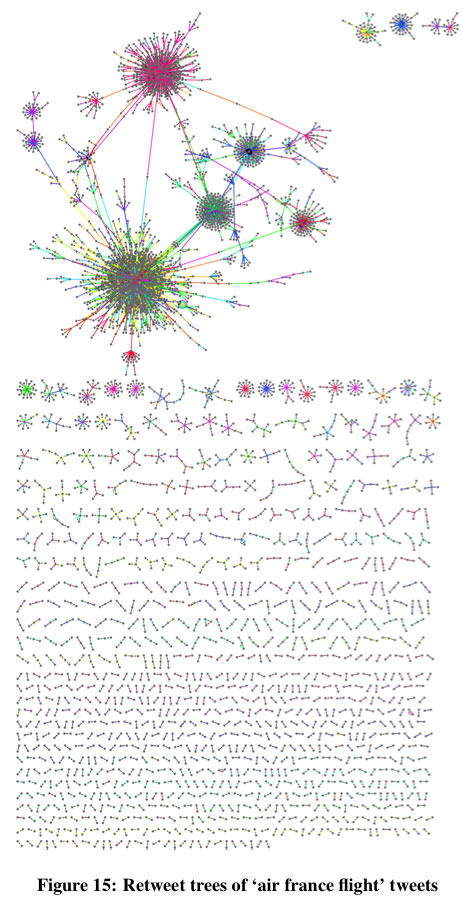An unprecedented analysis reveals that the micro-blogging service is remarkably effective at spreading "important" information.
It's basically impossible for a journalist who relies on Twitter to find stories, stalk editors, rack up "whuffie" and beef with rap stars to be objective about the service.
Fortunately, I don't have to be, because four researchers from the Department of Computer Science at the Korea Advanced Institute of Science and Technology have performed a multi-part analysis of Twitter. They conclude that it's a surprisingly interconnected network and an effective way to filter quality information.
In a move unprecedented in the history of academic research on Demi Moore's chosen medium for feuding with Kim Kardashian, Kwak et al. built an array of 20 PCs to slurp down the entire contents of Twitter over the course of a month. If you were on Twitter in July 2009, you participated in their experiment.
|
This "retweet tree analysis" shows instances of retweeting. When a message is retweeted just a few times it reaches a huge number of users. Credit: Kwak et al. |
Four Degrees of Separation
The ideas behind Stanley Milgram's original "six degrees of separation" experiment, which suggested that any two people on earth could be connected by at most six hops from one acquaintance to the next, have been widely applied to online social networks.
On the MSN messenger network of 180 million users, for example, the median degree of separation is 6. On Twitter, Kwak et al. hypothesized that because only 22.1% of links are reciprocal (that is, I follow you, and you follow me as well) the number of degrees separating users would be longer. In fact, the average path length on Twitter is 4.12.
What's more, because 94% of the users on Twitter are fewer than five degrees of separation from one another, it's likely that the distance between any random Joe or Jane and say, Bill Gates, is even shorter on Twitter than in real life.
Information as Outbreak
"...No matter how many followers a user has, the tweet is likely to reach [an audience of a certain size] once the user's tweet starts spreading via retweets," says Kwak et al. "That is, the mechanism of retweet has given every user the power to spread information broadly [...] Individual users have the power to dictate which information is important and should spread by the form of retweet [...] In a way we are witnessing the emergence of collective intelligence."
If this reminds of you early 90's hyperbole about the then-new world wide web, it should! Back then the web was a raucous, disorganized, largely volunteer-led effort full of surprisingly informative Geocities pages and equally uninformative corporate websites.
These days we have to contend with the creeping power of what can only notionally be defined as media "content"--produced purely to appear at the top of search results. But it appears that the (so far) still entirely human-filtered paradise of Twitter may come to the rescue. Owing to the short path length between any two users, news travels fast in the tweet-o-sphere.
Earlier work suggested that the best way to get noticed on Twitter was to tweet at certain times of day, and Kwak et al.'s paper sheds some light on why this is the case: "Half of retweeting occurs within an hour, and 75% under a day." And it's those initial re-tweets that make all the difference: "What is interesting is from the second hop and on is that the retweets two hops or more away from the source are much more responsive and basically occur back to back up to 5 hops away."
There Are a Lot of Lonely People on Twitter
Clashing with the service's interconnectivity, Kwak et al.'s analysis also suggests that there are a lot of lonely people on Twitter, and not just the ones who are tweeting angry political screeds at 8 pm on a Saturday night. "67.6% of users are not followed by any of their followings in Twitter," they report. "We conjecture that for these users Twitter is rather a source of information than a social networking site."
Another possibility, left unexplored by Kwak and his colleagues, is simply that on Twitter, like real life, some people are much more popular than others.
Aside from its monkey + keyboard simplicity, the fact that links on Twitter do not have to be reciprocal may be its ultimate genius. To that end, I urge all of you to follow Technology Review on Twitter. I must warn you that, as an enormously influential inanimate object, it has no empathy or conscience, so don't take it personally when it doesn't follow you back.

